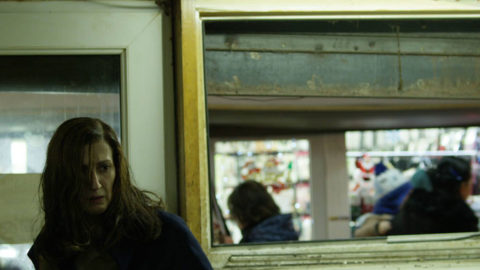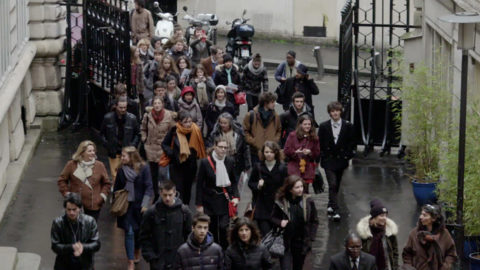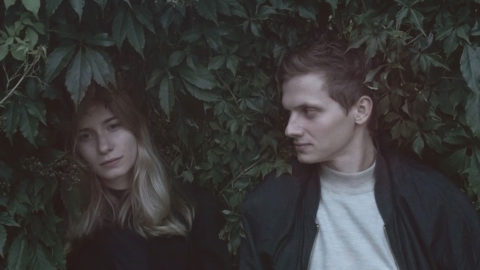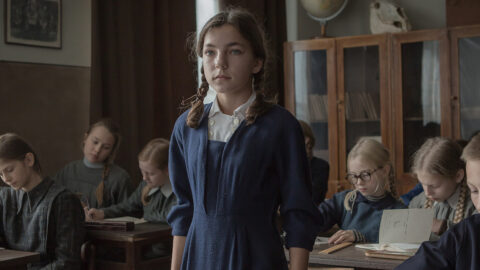Interview: Anna Zamecka
Everything about Anna Zamecka’s hybrid documentary Communion is surprising, perhaps most of all the worldwide critical and popular acclaim for this quietly perceptive and detailed film about a teenage girl growing up in a poor, troubled family in a small town just outside of Warsaw, Poland. Now playing a limited run through January 10 at IFC Center and throughout January at theaters across the U.S., it was the winner of the European Film Award for documentary and, as Poland’s nominee for an Oscar in the documentary category, is one of 15 films now on the shortlist. Largely funded by HBO Europe, Communion has already played on that network and in major festivals since the summer of 2016, when it debuted in Locarno and won the Critics’ Week top prize there. It first showed in the U.S. in the 2017 True/False Film Fest. This slow rollout is what allowed the film to qualify for a documentary Oscar nomination under the recent rule change which accepts winning at least three awards at major festivals in lieu of the former theatrical release requirement.
Three years in the making, Communion is Zamecka’s first film. She studied anthropology, journalism, and photography in college, and was attending the Dok Pro Program at the Wajda filmmaking school in Warsaw, when, in 2012, she saw a man in a railroad station who she thought would make an interesting subject for a short documentary. Marek Kaczanowski was a single father living with his then 12-year-old daughter, Ola, and 10-year-old son, Nikodem. Their mother, Magdalena, was living elsewhere, and because Marek was an alcoholic, Ola had become the head of the household, responsible not only for cooking and cleaning but also for the care for her younger brother, Nikodem, who has autism but is high-functioning, brilliantly original, and very difficult to manage. When Marek told Zamecka about his children, she realized there was a parallel with her own childhood experience. Although her own family was financially well-off and university-educated, she too had been charged even before she reached adolescence with caring for her younger brother all day. She felt that the burden was too heavy and that it had deprived her some of the experience of being a child herself, and then of having a teenage life. Although the film engages the Kaczanowski family as a whole, it is shaped by Zamecka’s empathy with Ola. We not only see events through Ola’s eyes, we often watch her reactions without needing to see who or what has triggered them.
On the recommendation of Agnieszka Holland, who described Communion as “one of the most beautiful, most humane films” she had seen in the last few years, I looked at Communion and interviewed Zamecka when she came to New York in November for an Academy screening. Here are some excerpts of what turned into a long discussion.
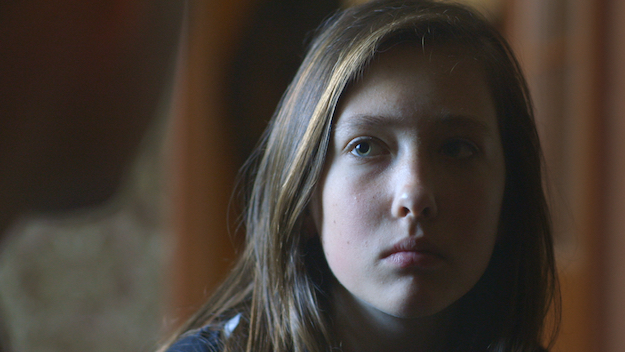
Could you describe your first meeting with Ola and Nikodem?
About a month after I met Marek, I went to their home. Ola and Nikodem were there alone. She was helping him with his homework. He seemed to have an assignment to write a letter to his mother. Ola explained that their mother had moved out, but she believed that if their father would renovate the bathroom, she would return. And this one sentence was like the beginning of something for me.
How old were they and how long did the process of shooting the film take.
Ola was 12 and Nikodem was 10. Before I began to shoot I spent a year with them. I knew I didn’t want to make anything that had an observational feel. I wanted to write a script and I knew it had to be precise because I only had enough money for 30 shooting days. For a film of almost 80 minutes, 30 days is not much. The film has many scenes, all of them are based on the observations I made during the year I spent with them without the camera.
What did you do while you were observing them?
I very quickly became part of this family, so that if Ola was cooking, sometimes I cooked with her. I think I made good contact with them because I feel like a kid myself. And I fell in love with Nikodem, this autistic kid. I felt so connected to him. He gave me so much from the first day. I understood very quickly how I would have to portray him. I don’t like the way disabled people are portrayed in many films where the director tries to make the audience feel sorry for the person. And of course I felt sorry for him, but it wasn’t as if he was disabled. For me, he was an angel, somebody who is perfect in the way he perceives reality, in his sensitivity, his curiosity, his love of nature. He sees himself as an animal because he says he doesn’t accept violence, and animals are not violent and human beings are. I wrote descriptions of all the characters that would be in the film, and this was how I described him.
Did the descriptions completely conform to your observations?
In real life they are more complex. The father is only a sketch, but I couldn’t go fully into who he is. But with Nikodem, I wanted to show that he has difficulty with some simple stuff. The film opens with him trying to tie his shoes. But I also show him as a prophet in his comments on what is happening around him.
It is so striking when he refuses to rehearse the text that he is supposed to recite at his communion because he doesn’t believe it. But when he makes the decision to succeed, he says it perfectly.
It was almost like a miracle. I shot the scene where Ola is preparing him for this exam three times. I wanted to show that she really cares, but the first time she wasn’t emotional enough about it. She thought that they had a lot of time to get it right. So when I realized that she wasn’t motivated enough, I set up a meeting with the priest without telling her. And that’s when I told her they had only three hours of preparation left.
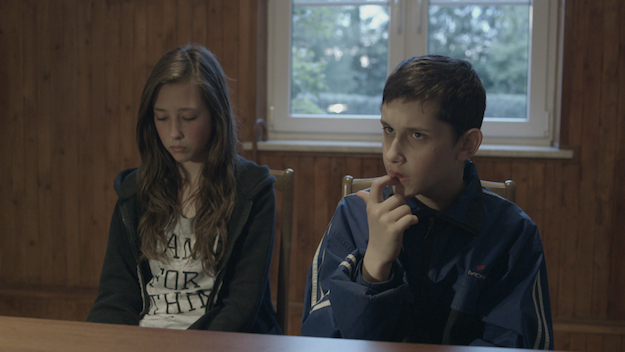
When you finally brought in the camera for these 30 days, how big a setup was it. Were there lights? How big a crew? The apartment is very small.
I liked lighting the real flat. It always seemed like a set to me. I loved the wallpaper and the fact that everything was falling apart, which was also a metaphor for the family. I knew that I couldn’t have more than two other people on the set and that I didn’t want to shoot it myself, because I had to do a lot of directing. We were all women. We prepared, partly by watching a lot of fiction films, but no documentaries at all. I was inspired by Oshima’s 1969 debut film Boy, particularly the scene where the boy is in the police station and he lies about his family. When she talks to the social worker and to the priest, Ola lies about her father because she’s worried that if they discover that he’s an alcoholic they will put her and Nikodem in foster care.
Was it the actual social worker who we see in the film?
Yes, but I didn’t show his face or the faces of the teacher and priest. I wanted to show that the system doesn’t work, but without blaming particular people. I didn’t want to have a socially involved interventionist camera. From the beginning we decided that the camera would follow emotion rather than action. That’s why when the social worker comes to the house, the camera is fixed on Ola’s face. We see through her how the system fails them.
And when the mother finally comes to see them, I presume it is the actual mother. She is the person in the film who might be blamed for the situation. She clearly doesn’t want to be with them. So I wondered about how you got her to cooperate and be in the film.
I really couldn’t understand why she’d agree. In fact, I didn’t understand why any of them agreed. It was all very difficult. We couldn’t shoot more than three days a month. The temperature of emotion on the set was very high. I think it was possible only because from the beginning I was honest with them about what I was doing there. I didn’t pretend that they were my friends or that I would help them with anything. I was honest about my intentions. But I was also sympathetic to Ola, because I had gone through a similar situation, and I didn’t pretend, like other people did, that everything was fine. I let her know that it was important to speak about the things she and the family were going through because no one else wanted to speak about these things. Other people would tell her that it was great that she was so strong, but that wasn’t what she wanted to hear, because she felt terrible about what was happening to them. I let them know that I was making a serious film about serious issues and they had to choose if they wanted to be part of it or not.
When the mother returns and then goes away again, how could you have scripted that turn of events in advance?
It’s a film about coming of age and becoming mature—to accept yourself as you are and others as they are. I wanted that acceptance for Ola—not that she would always wait for her mother to come back, but that she could accept that she might never come back. That she would be released from the old dream and would have new dreams. So in my script, I had a scene where she would go to the mother’s apartment for the first time and she would see her mother’s new baby, and they would say goodbye. But in the course of the filmmaking, the mother had personal problems with her partner and she decided to move out. I didn’t meet her until 2013 and when we met she was very scared but we became close. I didn’t want to judge her. When men leave the family, no one questions it, but when women leave, they are condemned. She probably had her reasons but I didn’t want to ask her. When I saw her for the first time she was in last months of pregnancy and she was living with her boyfriend in a room at his mother’s place. It was like a teenager’s room. So it was a matter of trust like with the rest of the family.
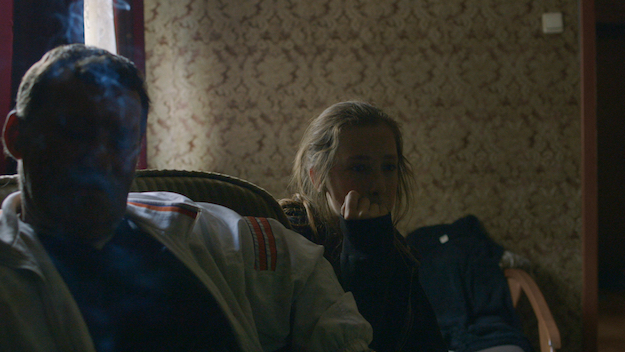
Did you write dialogue for the scenes?
I tried once at the beginning [of a different film project] but it didn’t work at all. But the idea for the Holy Communion was mine. Everyone in Poland has Holy Communion, usually at the age of eight. But Nikodem had never done this. I was curious about why, but Ola and her father didn’t want to talk about it. So when I was working on the script, I went to his religion lesson. The teacher asked him to write the Ten Commandments. But instead he wrote his own commandments. “Rescue me.” “Do not hit her.” They were very personal. He wrote that “God doesn’t reject me because Nikodem is an endangered species.” So I thought it would be very interesting to show him dealing with this situation of Holy Communion because he has his own ideas about religion and he doesn’t take any bullshit. Ola finally said the priest didn’t think he was ready in the spiritual sense. It was clear they were afraid he destroy the ceremony. And the family didn’t question the priest because they didn’t want Nikodem to stand out. They wanted him to be normal. But they also were embarrassed that he didn’t have communion. The word autism is never mentioned by anyone, not by the family or the teachers, the priest, the social workers. They think if they don’t talk about it, it doesn’t exist. And so he’s neglected. They refuse to see him.
So I said to Ola, let’s try. And then I realized why this was so important to me. I’m not Catholic myself, but in Poland the first communion is a family celebration, and I knew Ola would invite their mother, and I would have a perfect storyline. And I would show Nikodem as a very creative person and at the same time make some comment about how the system works in Poland. The Polish Catholic Church is the biggest tragedy of Poland. The title Communion isn’t just about communion as Catholic ritual, it’s a larger concept of what communion is. When I came up with this idea, the film became so much easier for me.
It’s very different from being a fly-on-the-wall documentarian. You coaxed them into doing something that changed their lives, and also is fulfilling as drama. The scenes where Ola tutors Nikodem are very moving. Has the family seen the film?
Yes, in the cinema in Warsaw. I didn’t know how they would react, but at the end the audience applauded for 10 minutes and everyone in the family was crying.
Could we talk a bit about your editing process? How long did it take?
Almost a year. We had an assembly in two weeks. But then a really great editor, Agnieszka Glinska, saw my rough cut assembly and decided to work with me. She’s mostly a fiction editor. She’s worked with great directors like Skolimowski. The two of us worked together for six months, and then I worked alone for another four months. It wasn’t about the structure, it was about the pace, the rhythm, small things. I went through the material many times.
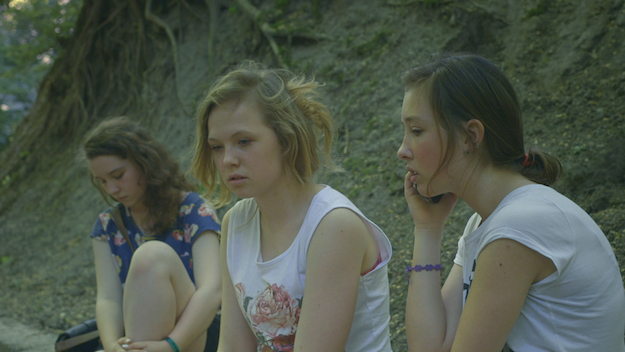
The time in the film is remarkable, as is the sense of what doesn’t have to be shown. How much footage did you end up with?
We had 80 hours. For instance we spent many hours with Nikodem, because we never knew what he would say or do. Editing is the most beautiful profession I know.
This is an amazing debut film. What made you go to film school?
From the time I was four years old, I was interested in theater. I wanted to act. When I was about 11, I began directing my friends in plays. And then when I was 15 I saw two films by Agnieszka Holland, The Secret Garden and Total Eclipse. And after seeing them, I thought I wanted not to act but to direct. But I was kind of floating around. It wasn’t until I was 29 that I thought, I have to make a film now or I never will. So sold my flat and I took the money and started this film and I also got some money from the Polish Film Institute. And then after we finished shooting I took seven minutes of the rough cut to some documentary film workshops where filmmakers pitched projects. People from HBO Europe were there, and they liked it and financed the post–production.
What do you want to do now?
I can’t imagine making an observational documentary. But I like this dialogue with the real world where there are surprises. I’d like to make something where no one can tell if it’s documentary or fiction. It would just be a film.
Amy Taubin is a contributing editor to Film Comment and Artforum.



